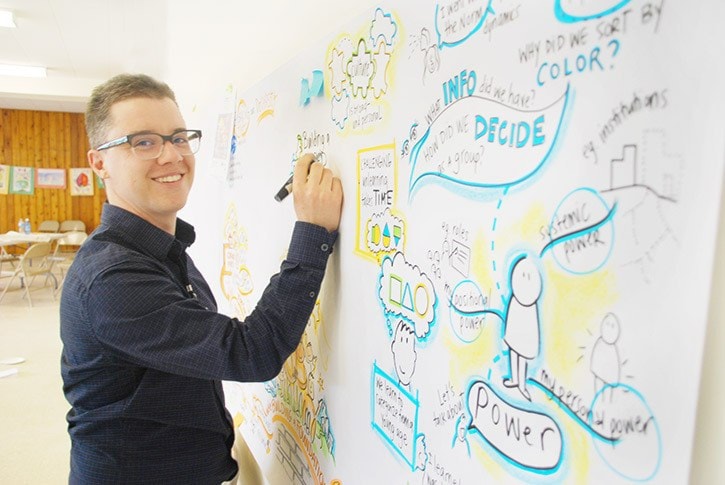An embracing our identity forum held in Williams Lake March 12 challenged participants to think about what makes a community inclusive — inclusive for individuals and for the community as a whole.
PeerNetBC’s executive director Iris Yong led the forum, engaging participants in a series of exercises and discussions.
At one point she placed a small plastic elephant on the floor in the middle of the room.
“That represents the elephant in the room,” Yong said. “The hidden agendas, secrets, things that inhibit us from creating shared understanding.”
Yong challenged participants to notice who has the power in the room and in the community.
“There are three types of power,” she said. “Personal, positional and overarching or systematic.”
There are layers of power, and situations people have no control over. And power is often defined by media, space, and health.
One of the exercises involved a coloured dot on the cheek of each person in the room.
Participants closed their eyes, had a dot placed on their right or left cheek, and then were asked to open their eyes and form into groups without talking.
Most people grouped themselves by one of the four colours, although two people went further and grouped themselves according to the fact their blue dots were on the same side of their faces.
Yong said in other situations people grouped themselves as a rainbow, ensuring each group had one of each colour. Some people like the Williams Lake participants grouped themselves according to the what side of the cheek the dots were on.
“There was a group of teenagers that didn’t move from their places. When I asked how they’d grouped themselves, one brave soul answered ‘by laziness’.”
From there participants broke up into small groups to discuss one word in what Yong termed the “staircase to oppression.”
Words such as experiences, stereotype, prejudice, discrimination and privilege were defined by the groups.
Yong suggested there is no such thing as a “good stereotype” because while they may sound good, they are always a generalization.
Homelessness worker Wayne Lucier recalled his childhood in a rural Metis town in Manitoba.
He attended a grades 1 - 9 school and did not realize he was Metis until that small school shut down and he went to a larger school.
“The teacher told me I was probably going to turn out like all the rest of us. I didn’t even know what she meant,” Lucier said.
Yong is a Chinese Canadian and grew up with the stereotype that “all Asians are good at math.”
She wasn’t good at math, she said. On top of that, people are never sure of her ethnicity to begin with.
“I’m asked if I’m First Nations, Filipino or Asian all the time,” she said.
The Fraser Basin Council hosted the forum and plans to use the information generated by participants for planning a diversity mural project.
Around 30 people attended the forum, ranging from elementary school age to retired.
